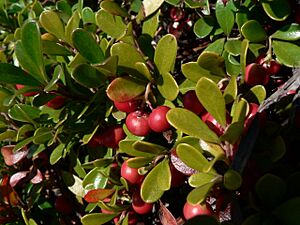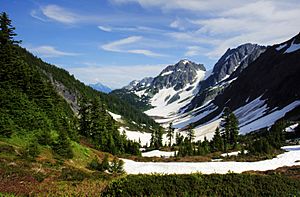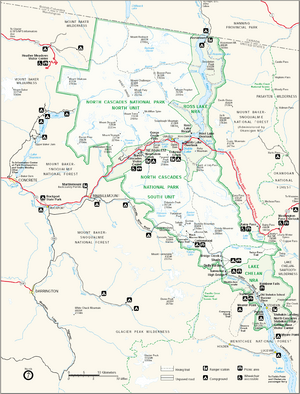North Cascades National Park facts for kids
North Cascades National Park is a special place in the U.S. state of Washington. It became a national park on October 2, 1968. The park is huge, covering about 634,000 acres of the Cascade Range, specifically the North Cascades mountains.
The park is divided into two parts by the Skagit River, which flows through it. Other important rivers include the Baker River and the Stehekin River, which flows into Lake Chelan.
North Cascades National Park is famous for its rugged mountain peaks. It has the largest system of glaciers (huge rivers of ice) in the mainland United States. The park is also where many rivers begin, and it has vast forests. These forests have more different kinds of plants and animals than almost any other U.S. national park!
Long ago, the area was first home to Native Americans called Paleo-Indians. By the time European explorers arrived, Skagit tribes lived there.
Contents
Amazing Mountains and Glaciers
North Cascades National Park is often called the "American Alps" because of its tall, jagged mountains. Many of these peaks are over 8,000 feet (2,400 meters) high.
Glaciers: Rivers of Ice
The park has over 300 glaciers. These are not just big chunks of ice; they are slow-moving rivers of ice that shape the landscape. Glaciers carve out valleys and create beautiful lakes. They also feed the rivers and streams in the park.
Tallest Peaks
The tallest mountain in the park is Goode Mountain, which stands at 9,200 feet (2,800 meters) tall. Other famous peaks include Mount Shuksan and Eldorado Peak. Climbing these mountains is a big challenge, but many people enjoy hiking to viewpoints to see them.
Waterways and Lakes
Water is a very important part of North Cascades National Park. The park has many rivers, streams, and lakes.
Important Rivers
The Skagit River is the main river that flows through the park. It's known for its powerful flow and for supporting a lot of wildlife. The Baker River and Stehekin River are also key waterways.
Beautiful Lakes
The park is home to several stunning lakes. Ross Lake is a large reservoir that is part of the Ross Lake National Recreation Area. Its deep blue-green water is surrounded by steep, forested slopes. Other beautiful lakes include the Thornton Lakes, which are found in basins carved by glaciers.
Plants and Animals
North Cascades National Park is a hotspot for biodiversity. This means it has a huge variety of plants and animals.
Forests and Plants
The park has many different types of forests, from dense lowland forests to high-elevation subalpine forests. You can find giant Douglas fir trees, western hemlocks, and cedars.

Some plants, like the common bearberry (Arctostaphylos uva-ursi), are usually found much further north. But in the park, they grow at higher elevations where it's colder.
Wildlife in the Park
The park is home to many amazing animals.
- Mammals: You might spot black bears, grizzly bears, cougars, and bobcats. Smaller mammals include marmots, pikas, and snowshoe hares. Mountain goats are often seen on steep, rocky slopes.
- Birds: Many different bird species live here, including bald eagles, peregrine falcons, and various owls. The sooty grouse (Dendragapus fuliginosus) is a common sight on trails.
- Fish: The rivers and lakes are home to different types of salmon and trout.
History of the Park
The area that is now North Cascades National Park has a rich history, especially with its first inhabitants.
Early People
For thousands of years, Native Americans lived in the North Cascades. They used the mountains and valleys for hunting, fishing, and gathering plants. They also traveled through the passes, like Cascade Pass, for trade.
Archaeologists have found tools like microblades, which are tiny stone tools, showing how early people used the land.
Becoming a National Park
The idea of protecting the North Cascades began in the early 1900s. People wanted to save its wild beauty from development. After many years of discussion, North Cascades National Park was officially created in 1968. This protected the area for future generations to enjoy.
Visiting the Park
North Cascades National Park is a great place for outdoor adventures.
Popular Activities
- Hiking: There are many trails for all skill levels, from easy walks to challenging mountain climbs. Cascade Pass is one of the most popular hiking destinations.
- Camping: The park offers several campgrounds where you can stay overnight and enjoy the wilderness.
- Boating: On lakes like Ross Lake, you can go boating, kayaking, or canoeing.
- Wildlife Viewing: Keep an eye out for the amazing animals that live in the park!
Park Access
The park is mainly accessed by State Route 20, also known as the North Cascades Highway. This road offers stunning views, but it is closed during winter due to heavy snow.
Images for kids
-
The south unit of the park is dominated by Eldorado Peak (left center skyline). Cascade Pass, one of the most popular hiking destinations in the park, is the lowest point on the skyline between Boston Peak (just right of center, with large glacier) and broad Johannesburg Mountain (right). Hidden Lake Peaks, another popular hike, are in the middle distance below and right of Boston Peak.
-
The Thornton Lakes fill glacier-carved basins near Mount Triumph
-
Common bearberry (Arctostaphylos uva-ursi) is a plant species normally found much further north but is found at higher elevations in the park.
See also
 In Spanish: Parque nacional de las Cascadas del Norte para niños
In Spanish: Parque nacional de las Cascadas del Norte para niños



























